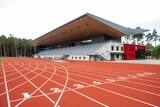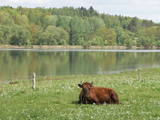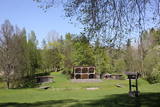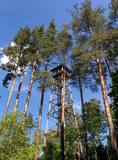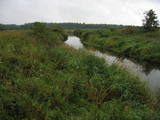| Нo | Название | Описание |
|---|---|---|
|
Семейный ресторан у Меллужской эстрады – в Юрмале, в 27 км от Риги. Предложение европейской и латышской кухни на все приемы пищи: супы дня, салаты, основные блюда, выбор десертов и уютная атмосфера. |
||
|
Осенью 2010 года на берегах пограничной реки Койва, разделяющей Эстонию и Латвию, открылась велосипедная дорожка длиной 60 км, знакомящая посетителей с объектами культурного наследия двух государств. Тропа начинается с парковки Теллингумяэ, на конечных пунктах тропы и в месте пересечения границы есть места отдыха и инфотаблички с общей схемой тропы. Указатели направлений установлены на таких перекрестках, где путешественник может растеряться. |
||
|
Ap 200 m garajā un izstieptās formas laukumā no 16. – 20. gs. atradās Liepājas tirgus. Laukuma malās tolaik bija izveidojusies vienstāvu apbūve – iebraucamās sētas, viesnīcas un dārzi. Līdz ar Pētertirgus izveidi 1910. gadā, izmainījās arī laukuma apveidi un to ieskaujošā apbūve. Laukuma DA malā slejas iespaidīgā Liepājas Svētās Annas Luterāņu baznīca. |
||
|
Крестьянское хозяйство «Ривени» занимается плодоводством и переработкой плодоводческих продуктов - сушеные яблоки, яблочный сок. |
||
|
Saimniecībā, kura atrodas pašā Sēlijas novada centrā, aug un zied vairāk nekā 400 dažādu rožu šķirnes, kā arī siltumnīcās tiek audzēti dažādi dārzeņu un puķu stādi. Iegādei tiek piedāvāti dažādi viengadīgie augi, vairāki simti rožu stādi un ēdamaugu stādi siltumnīcai un dārzam. |
||
|
Изначально был открыт в 1938-м году, но позже многократно перестроен. Возле стадиона установлен памятный камень в честь Яниса Далиньша (1904 – 1978), который являлся многократным рекордсменом мира в спортивной ходьбе. В 1932-м году на Олимпийских играх в Лос-Анджелесе Я. Далиньш занял второе место в спортивной ходьбе. На стадионе в 1993-м году состоялись первые всемирные латышские Олимпийские игры Трех Звезд. В наши дни стадион Далиньша является легкоатлетическим стадионом государственного значения, на котором проходят международные соревнования, и местом для занятия спортом, получившем статус самого дружественного места для молодежи. |
||
|
Профессиональный сельскохозяйственный тур, в ходе которого будет возможность ознакомиться с плодоводческими хозяйствами, которые селекционируют, выращивают и размножают сорта, пригодные для климатических условий Латвии. День знакомства, в течение которого запланирован осмотр Риги – столицы Латвии (наследие ЮНЕСКО) и посещение магазина продуктов для здорового питания. В первый день отправляемся в Курземе и посещаем хозяйство, которое разработало особую технологию, где в процессе переработки облепихи сохраняются все вещества и витамины, находящиеся в ягодах. Посещение Сабильской Винной горы. Это место, где виноград выращивали уже в 16 – 17 веках. В наши дни здесь растут примерно 15 разных сортов винограда, приспособленных для выращивания в Латвии. Следующий объект осмотра – поместье «Кукшу», в котором можно ознакомиться с культурной средой исторических поместий Латвии 18 – 19 веков. Возвращение в Ригу через курорт Юрмала. Ужин в латышской таверне. На следующее утро отправляемся в Видземе и посещаем место, где впервые в Латвии начали разрабатывать бывшее торфяное болото и выращивать на нем крупноплодную клюкву. Хозяйство разработало и свои технологии переработки, производит цукаты, сиропы, соки, чаи. В следующем место впервые в Латвии начали выращивать кустовую чернику. Экскурсия и дегустация. В завершении дня – хозяйство, в котором выращивают клюкву и чернику. Оно отличается успешным производством продуктов для здорового питания и их маркетингом. Утром четвертого дня – осмотр Цесисского средневекового замка. Цесисский замок был резиденцией магистров Ливонского ордена и одной из сильнейших крепостей ордена на сегодняшней территории Балтии. Посещение Приекульского сельскохозяйственного техникума и встреча с преподавателями. В завершении дня – поместье Унгурмуйжа – один из выдающихся образцов деревянного барокального строительства в Латвии 18-го века. Господский дом поместья (1732 г.) – единственный деревянный дворец начала 18-го века, сохранившийся в Латвии. |
||
|
The nature park in the Daugava River valley is the only place between the cascades of the Daugava hydroelectric power plants there is still a chance to see the Daugava River valley and the ravines of its tributaries as they appeared before the area was flooded so that the power plants could be constructed. Particularly lovely views are found on the right bank of the river near the Aizkraukle church and castle hill. Forests, meadows, origins of streams and small dolomite cliffs in this area are all protected biotopes. Leisure facilities have been installed on the Aizkraukle castle hill, and the Aizkraukle castle ruins are not far away. |
||
|
В месте, где правый основной берег древней долины Гауи раскалывают несколько глубоких оврагов с маленькими ручьями, расположился Турайдский музей-заповедник с выдающимися в масштабе Балтии памятниками, история которых уходит в 1000-летнее далекое прошлое. Среди них необходимо упомянуть Турайдскую господскую усадьбу (21 здание), могилу Турайдской Розы, Турайдскую лютеранскую церковь (одна из старейших (1750 г.) деревянных церквей Латвии) и Турайдский замок. Рядом на горе Дайн организуются всевозможные тематические мероприятия. |
||
|
Спа-отель Lohja расположен в красивом месте недалеко от озера Лохья, в окружении мирной природы. Здесь вы можете взять напрокат велосипед и / или лодку, пойти в тренажерный зал, поиграть в мини-гольф, поплавать и многое другое. |
||
|
В хозяйсте производят молоко, йогурт, творог, сметану, сливки и сыр, используя молоко коров, выращенных в хозяйстве. В стаде 70 голов. Каждую пятницу продукцию можно приобрести на месте – в хозяйстве. |
||
|
Один из важнейших справочных объектов природного парка, который обустроен в столетнем, характерном для исторического края Селии хуторе. Здесь предоставлена возможность ознакомиться с посвященной парку экспозицией, приобрести изделия местных ремесленников и крестьян, а также отведать настойку из бобровой струи! На севере и востоке от «Гулбьи» находится загон острова Путну (250 га) с домашними животными, которые приспособились к жизни в дикой природе – лошади породы Коник и коровыпородыХайлендер. На берегу озера Скукю, на расстоянии 0,5 км установлена вышка для наблюдения за птицами.
|
||
|
До Силмачи нужно ехать через бор в Перлисе и через малонаселенные места. Здесь в 80-х годах 20 века построена эстрада под открытым небом для одного спектакля Рудольфа Блауманя „Дни портных в Силмачи”, который ставился в Латвийском национальном театре в 1986 году на праздник Лиго . Рядом с эстрадой также в 1986 году создан музей, посвященный данной тематике, в котором, наряду с другими экспонатами, можно увидеть также рукопись пьесы сохранившись с 1902-го года. |
||
|
В основном здании уездного музея (открыт круглогодично) и его филиалах (открыты в летний период) дан обзор истории возникновения Хийумаа, обзор истории мореходства, сельского хозяйства и мыз, рассказано о царском и Эстонском временах, истории шерстяной фабрики в Кярдла, советском времени и о многом другом интересном. В Длинном доме можно проводить уроки по традиционной культуре. |
||
|
Uzcelts apkaimes augstākajā vietā – Ančupānu meža kalnā, kuru vietējie dēvē par „Bāku”. No 26 m augstā torņa redzama ļoti plaša panorāma ar Rēzeknes pilsētas namiem, baznīcu torņiem un apkaimes mežu masīviem, kas mijas ar lauksaimniecībā izmantojamām zemēm. Blakus tornim – atpūtas vieta. |
||
|
Многовековой извилистый Почтовый тракт ведет к основанной в 1863 году почтовой станции Варбузе, где когда-то была конюшня и куда регулярно доставляли почту. Сегодня в старом, но хорошо сохранившемся комплексе зданий почтовой станции расположен Эстонский дорожный музей. |
||
|
One of the few places in Latvia where there are so many well-organised pathways. The region is known for castle hills, the location where the great Latvian author Anna Brigadere (1861-1933) lived and worked, the storybook character figures that are scattered around that area, a great forest, an arboretum, a museum of history, a viewing tower, landscapes, etc. This has been recognised as the most family-friendly place in the country.
|
||
|
Talsu vecpilsētā, pašā vēsturiskā centra vidū, atrodas īpaša vieta, kur saplūst lauku miers un pilsētas dzīvīgums. Te vari izbaudīt gan klusumu un nesteidzīgu atmosfēru, gan arī sajust tuvumā esošo ielu dzīves ritmu. Šī māja ir kā radīta romantiskam nedēļas nogales atpūtam divatā — vakarā iekurt kamīnu, iemirdzināt telpu sveču gaismā un baudīt siltu vīna glāzi klusā divvientulībā. Tajā pašā laikā tā lieliski piemērota arī ģimenēm vai draugu kompānijām, kas vēlas pavadīt laiku kopā ērtā un plašā vidē. Villā pieejamas piecas guļamistabas, divas vannas istabas, kvalitatīva gultas veļa un dvieļi, satelīttelevīzija plakanajā ekrānā, ērta ēdamzona, pilnībā aprīkota virtuve, kā arī terase ar skatu uz dārzu. Papildus ērtībām viesiem ir atpūtas zona un kamīns, kas lieliski papildina vietas mājīgumu. |
||
|
Palieņu pļavas starp Rūjienu un Rūjas ieteku Burtnieku ezerā, kurām raksturīga liela augu un putnu sugu daudzveidība. Tās robežojas ar bijušiem Rūjas zivju dīķiem, kas šobrīd aizaug ar mežu. Rūjas palienes var vērot gan braucot ar laivu pa Rūju, gan arī no ceļa, kas ved uz minētajiem dīķiem. Tur izvietots informācijas stends.
|
||
|
В этом месте можно почувствовать красоту природы, ее силу, энергию, быть в гармонии с природой, не только испытать энергию растений, Латышских знаков и земли, но и полюбоваться камнями – украшением сада. Ботанический сад с видом на море и каскадом водопадов, которые радуют глаз весной и осенью, а летом - это каменная река. Сад находится в 1 км к северу от остановки автобуса Туя. В саду представлены 28 видов хвойных растений, 14 видов декоративных кустарников, а также 13 сортов рододендронов, альпинарий (каменный сад) и многолетники. Есть интересная коллекция камней, можно определить их энергетическое поле, сад с эзотерикой. Можно осмотреть каменистое Видземское побережье. Ботанический сад неоднократно удостаивался наград на уровне Салацгривского края и в масштабе государства. |
||









